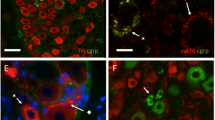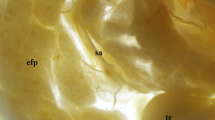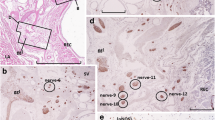Summary
An immunohistochemical study in which antisera against several neuropeptides were used demonstrated the presence of neuropeptide Y(NPY) and vasoactive intestinal polypeptide (VIP) immunoreactivity in nerve fibers in the human prostate gland and seminal vesicle, whereas no immunostaining for substance P and calcitonin gene-related peptide was observed. The peptidergic innervation was found to be generally moderate to low. NPY-and VIP-immunoreactive fibers were localized in the subepithelial connective tissue as well as the smooth muscle layers in both organs, although the peptidergic fiber networks were more prominent in the seminal vesicle. Most NPY-immunoreactive fibers were observed in the musculature of the seminal vesicle.In addition, NPY-and VIP-immunoreactive fibers were demonstrated in the walls of blood vessels. The results of our study suggest that the innervation of the prostate gland and seminal vesicle by various neuroactive peptides may be involved in the autonomic regulation of these organs in adult man, as well as sympathetic and parasympathetic nerve fibers.
Similar content being viewed by others
References
Aumüller G (1979) Prostate gland and seminal vesicles. In: Oksche A, Vollrath L (eds) Handbuch der mikroskopischen Anatomie des Menschen VII/6. Springer, Berlin Heidelberg New York
Aumüller G, Metz W, Grube D (1976) Electron-and fluorescence-microscopical investigations of the human prostate (in German) Verh Anat Ges 70:895
Baumgarten HG, Falck B, Holstein A-F, Owman C, Owman T (1968) Adrenergic innervation of the human testis, epididymis, ductus deferens and prostate: a fluorescence microscopic and fluorimetric study. Z Zellforsch 90:81
Bird ED (1981) Problems of peptide-analysis in human postmortem brain. In: Martin JB, Reichlin S, Blick KL (eds) Neurosecretion and brain peptides. Raven Press, New York, p 657
Bullon A, Lopez FL (1959) On the innervation of the human seminal vesicle and the homological organ in the dog (in German). Z Mikrosk Anat Forsch 65:133
Casas AP (1958) The innervation of the human prostate gland (in German). Z Mikrosk Anat Forsch 64:608
Denissov-Nikolskiĩ JI (1969) On the state of nerve cells of organ plexus of the prostate after castration (in Russian).Bull Eksp Biol Med [Moskva] 67:107
Everitt BJ, Hökfelt T, Terenius L, Tatemoto K, Mutt V, Goldstein M (1984) Differential co-existence of neuropeptide Y (NPY)-like immunoreactivity with catecholamines in the central nervous system of the rat. Neuroscience 11:443
Flickinger CJ (1972) The fine structure of the interstitial tissue of the rat prostate. Am J Anat 134:107
Hervonen A, Vaalasti A, Vaalasti T,Partanen T, Kanerva L (1976) Paraganglia in the urogenital tract of man. Histochemistry 46:307
Hökfelt T, Johansson O, Goldstein M (1984) Chemical anatomy of the brain. Science 225:1326
Jabonero V, Genis MJ, Santos L (1963) Observations on the osmium-zinciodine positive elements of the prostate gland (in German). Z Mikrosk Anat Forsch 69:167
Jacobowitz DM, Olschowka JA (1982) Bovine pancreatic polypeptide-like immunoreactivity in brain and peripheral nervous system: coexistence with catecholaminergic nerves. Peptides 3:569
Johnson FP (1920) The later development of the urethra in the male. J Urol 4:447
Lange W, Basting-Krieglsteiner C, Debbage P, Unger J (1986) Are motilin and CGRP cerebellar peptides? An immunohistochemical, chromatographic and radioimmunological study. Neurosci Lett [Suppl 26]:S322
Lange W, Unger J, Weindl A, Lang RE (1989) Demonstration of atrial natriuretic peptide/cardiodilatin (ANP/CDD)-immunoreactivity in the salt gland of the Pekin duck. Anat Embryol 179:465
Larsson L-I (1977) Occurrence of nerves containing vasoactive intestinal polypeptide immunoreactivity in the male genital tract. Life Sci 21:503
Oertel WH, Graybiel AM, Mugnaini E, Elde RP, Schmechel DE, Kopin J (1983) Coexistence of glutamic acid decarboxylase and somatostatin-like immunoreactivity in neurons of the feline nucleus reticularis thalami. J Neurosci 3:1322
Sjöstrand NO (1965) The adrenergic innervation of the was deferens and the accessory male genital glands. An experimental and comparative study of its anatomical and functional organization in some mammals, including presence of adrenalin and chromaffin cells in these organs. Acta Physiol Scand 65: [Suppl 1]:1
Smith ER, Miller TB, Wilson MM, Appel MC (1984) Effects of vasoactive intestinal peptide on canine prostatic contraction and secretion. Am J Physiol 247:R701
Sofroniev MW (1983) Golgi-like immunoperoxidase staining of neurons producing specific substances or of neurons transporting exogenous tracer proteins. In: Cuello AC (ed) Immunohistochemistry. IBRO, p431
Sternberger LA (1979) Immunocytochemistry, 2nd edn. Wiley, New York
Stjernquist M, Håkanson R, Leander S, Owman C, Sundler F, Uddman R (1983) Immunohistochemical localization of substance P, vasoactive intestinal polypeptide and gastrin-releasing peptide in vas deferens and seminal vesicle, and the effect of these and eight other neuropeptides on resting tension and neurally evoked contractile activity. Regul Pept 7:67
Stjernquist M, Owman C, Sjoeberg NO, Sundler F (1987) Coexistence and cooperation between neuropeptide Y and norepinephrine in nerve fibers of guinea pig vas deferens and seminal vesicle. Biol Reprod 36:149
Unger J (1984) Somatostatin and vasoactive intestinale polypeptide in rat and human brain and cerebrospinal fluid of patients with neurodegenerative diseases: immunohistochemical and radioimmunological investigations (in German). Inaugural dissertation, University of Munich
Vaalasti A, Linnoila I, Hervonen A (1980) Immunohistochemical demonstration of VIP, Met5-and Leu5-enkephalin immunoreactive nerve fibres in the human prostate and seminal vesicle. Histochemistry 66:89
Vaalasti A, Tainio H, Pelto-Huikko M, Hervonen A (1986) Light and electron microscope demonstration of VIP-and enkephalinimmunoreactive nerves in the human male genitourinary tract. Anat Rec 215:21
Watzka M (1928) On the occurrence of multiple nuclei in ganglionic cells of nerve fiber networks in the seminal vesicle (in German). Anat Anz 66:321
Author information
Authors and Affiliations
Additional information
The work reported in this paper was supported by the Walter-Schulz-Stiftung and the Friedrich-Baur-Stiftung
Rights and permissions
About this article
Cite this article
Lange, W., Unger, J. Peptidergic innervation within the prostate gland and seminal vesicle. Urol. Res. 18, 337–340 (1990). https://doi.org/10.1007/BF00300783
Accepted:
Issue Date:
DOI: https://doi.org/10.1007/BF00300783




